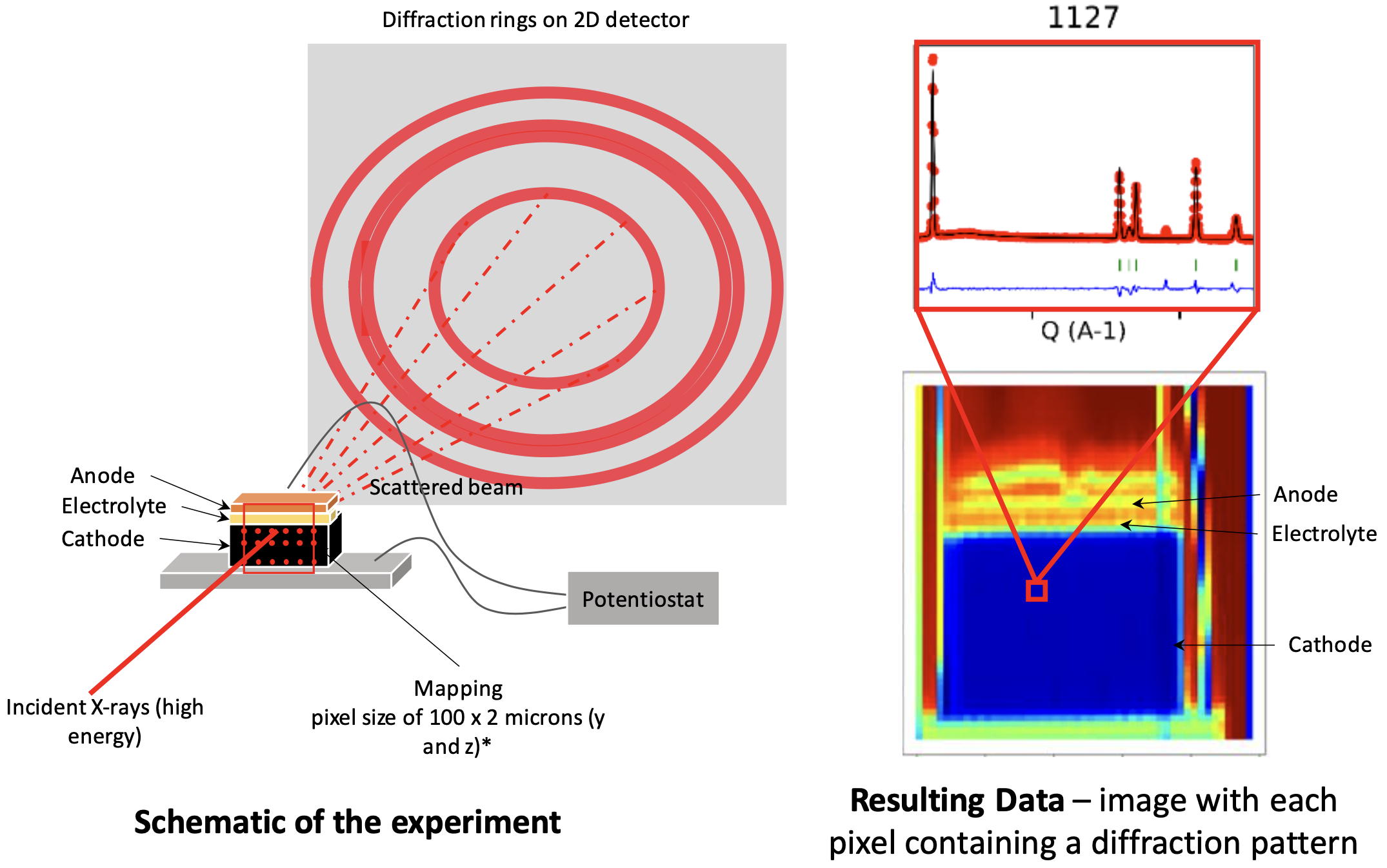 Background
Background
Operando characterization to understand and improve Li-ion batteries Efficient, safe, and environmentally-friendly energy storage is a key requirement to successfully transitioning from depleting fossil fuels to renewable energy sources. In this regard, Li-ion batteries are playing a decisive role, particularly in meeting the demands of a highly mobile society. Nevertheless, there are great challenges remaining towards the worldwide success of battery-powered electric vehicles, which mostly revolve around increasing the energy density and improving fast charging. Increasing the energy density can be achieve by (1) increasing the active material fraction in the battery (limiting ‘dead’ weight associated to battery casing, unnecessary porosities, and materials) and (2) using high energy density materials. Fast charging typically leads to detrimental reactions such as (1) Li dendrite growth, being a microfilament of Li metal growing for the anode to the cathode, potentially leading to short circuit, (2) kinetically driven heterogeneous lithiation at the micro and nanoscale which might lead to underutilization of active material (some part of the anode or cathode don’t store lithium ions, hence reducing the capacity). In this internship, we will be focusing on understanding the
lithiation mechanism of all-electrochemically- active anode-less micro batteries using advanced synchrotron X-ray characterization techniques.
All-electrochemically-active anode-less micro batteries are close to commercial Li-ion batteries in which the cathode electrode consists of 20 micron thick 100% active material film (no binder, no pores, no electrolyte – hence an ideal energy density), while the anode is just a thin metallic layer on which Li metal is deposited during charge and stripped during discharge (no anode active material, no binder, no pores, no electrolyte). A solid state electrolyte is deposited in between the two electrodes. This design is optimal for energy density but stringent for fast charging applications. Indeed fast (dis)charging is limited by Li diffusion inside the active material electrode leading to Li concentration heterogeneities which have recently been modelled
1. Measuring these Li concentration gradients to validate the model and understand the limitation in such systems is crucial.
Large Scale facilities operando tools: microbeam X-ray diffraction Measuring Li concentration during fast charging at the sub-micron scale inside a battery is extremely challenging and can’t be performed using standard characterizations, hence the need to develop advanced characterization techniques. ESRF (synchrotron) is an European Large Scale Facility providing high energy and high flux X-ray beams to perform unique cutting edge characterization experiments. They are particularly useful for
operando battery characterization (
operando means time resolved characterizations during battery operation) because synchrotron X-ray can i) penetrate deeply into matter and hence probe inside a working battery, ii) can give information from the micron to nanoscale with short acquisition time. In particular, in
Operando Synchrotron microbeam X-ray Diffraction (ESRF) a micro X-ray beam is scanned over the battery, and is scattered by crystalline electrode material inside the battery. Scattered beams are collected onto a detector. This technique allows to map at the micron scale (beam sizes have typically 5 x 20 microns) the structural evolution of battery materials under real conditions during Li insertion/extraction
2,3.
 The internship
The internship
The aim of the intern is to analyze micro diffraction data obtained on microbatteries.
The team has already obtained micro diffraction imaging data on micro batteries and the goal of the internship is to participate in the data analysis, answering the questions: Can we see Li concentration gradients in the cathode material, in the electrolyte? What are the characteristic of deposited Li metal at the anode side? Its crystallographic orientation, grain sizes and dynamic evolution during cycling? The intern will be working for 6 months at CEA in Grenoble, a major French National Lab focused on the development of low-carbon energies, and more specifically at the IRIG, the fundamental science department of CEA. Data analysis will be perform using python codes already written by the team but that will need to be modified. Data interpretation will be discussed with X-ray diffraction experts in our teams and micro batteries experts also located in CEA-Grenoble. Findings will be useful to understand the behavior of these systems from a fundamental point of view but also to provide guidelines for design optimization.

Schematic of a microXRD experiments perform ona micro-battery.
 Requested skills
Requested skills
M2 master student with a knowledge in data analysis (python) or material characterization (diffraction, imaging) or energy storage devices (Li-ion batteries) will be important.
Possibility to follow with a PhD. Ecoles Doctorales: Ed Physique
 Start and duration of the internship
Start and duration of the internship
February - March 2024
Duration : 5- 6 months
 References
References
(1) Celè, J.; Franger, S.; Lamy, Y.; Oukassi, S. Minimal Architecture Lithium Batteries: Toward High Energy Density Storage Solutions. Small 2023, 19 (16), 2207657. https://doi.org/10.1002/smll.202207657.
(2) Berhaut, C. L.; Dominguez, D. Z.; Kumar, P.; Jouneau, P.-H.; Porcher, W.; Aradilla, D.; Tardif, S.; Pouget, S.; Lyonnard, S. Multiscale Multiphase Lithiation and Delithiation Mechanisms in a Composite Electrode Unraveled by Simultaneous Operando Small-Angle and Wide-Angle X-Ray Scattering. ACS Nano 2019, 13 (10), 11538–11551. https://doi.org/10.1021/acsnano.9b05055.
(3) Tardif, S.; Dufour, N.; Colin, J.-F.; Gébel, G.; Burghammer, M.; Johannes, A.; Lyonnard, S.; Chandesris, M. Combining Operando X-Ray Experiments and Modelling to Understand the Heterogeneous Lithiation of Graphite Electrodes. J. Mater. Chem. A 2021, 9 (7), 4281–4290. https://doi.org/10.1039/D0TA10735B.
 To apply, please contact:
To apply, please contact:
 Laboratory / Team
Laboratory / Team